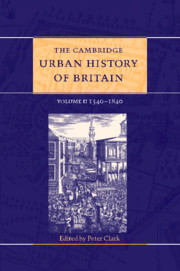Book contents
- Frontmatter
- 1 Introduction
- Part I Area surveys 1540–1840
- Part II Urban themes and types 1540–1700
- Part III Urban themes and types 1700–1840
- 14 Urban growth and economic change: from the late seventeenth century to 1841
- 15 Population and society 1700–1840
- 16 Politics and government 1700–1840
- 17 Culture and leisure 1700–1840
- 18 The transformation of urban space 1700–1840
- 19 London 1700–1840
- 20 Regional and county centres 1700–1840
- 21 Ports 1700–1840
- 22 Small towns 1700–1840
- 23 Health and leisure resorts 1700–1840
- 24 Industrialising towns 1700–1840
- 25 Conclusion
- Select Bibliography
- Index
- References
21 - Ports 1700–1840
from Part III - Urban themes and types 1700–1840
Published online by Cambridge University Press: 28 March 2008
- Frontmatter
- 1 Introduction
- Part I Area surveys 1540–1840
- Part II Urban themes and types 1540–1700
- Part III Urban themes and types 1700–1840
- 14 Urban growth and economic change: from the late seventeenth century to 1841
- 15 Population and society 1700–1840
- 16 Politics and government 1700–1840
- 17 Culture and leisure 1700–1840
- 18 The transformation of urban space 1700–1840
- 19 London 1700–1840
- 20 Regional and county centres 1700–1840
- 21 Ports 1700–1840
- 22 Small towns 1700–1840
- 23 Health and leisure resorts 1700–1840
- 24 Industrialising towns 1700–1840
- 25 Conclusion
- Select Bibliography
- Index
- References
Summary
THE DIVERSITY OF PORTS
ports were among the most dynamic towns during the commercial and Industrial Revolutions in Britain. They were also exceedingly diverse. By definition they were all boroughs or burghs with members of parliament, and councils controlling their domestic affairs. They enjoyed monopoly rights over foreign and most coastal trade. An English law of 1558 restricted trade to specified places and designated Legal Quays within them where all customable goods must be handled. There were approximately seventy-two English ports from 1696, when the customs service was reformed. In Scotland only designated royal and certain baronial burghs could trade overseas, and these were organised in thirteen precincts before the Union and approximately thirty ports thereafter. Although ports were separate entities, to some extent they competed with each other as part of the general or regional transportation system, but they shared characteristics that can be dealt with across the spectrum of places and activities.
By definition ports grew round a waterfront, preferably the mouth of a river linking them to a hinterland, or, less successfully, a stretch of seashore enclosed by a pier or piers and dependent on land carriage. Almost universally throughout northern Europe this waterfront was lined originally with private warehouses backing on to merchants’ houses facing the main street, maximising ground area while minimising expensive water frontage. There was usually a secondary centre round a market serving the local distribution network. In the eighteenth century the ground plan was elaborated in busy ports, with further streets for warehouses. However, the high cost of cartage and government failure to extend Legal Quays encouraged concentration round the waterside, raising land values and confirming the economic domination of those who owned it, with unfortunate effects for later developments.
- Type
- Chapter
- Information
- The Cambridge Urban History of Britain , pp. 705 - 732Publisher: Cambridge University PressPrint publication year: 2000
References
- 26
- Cited by

